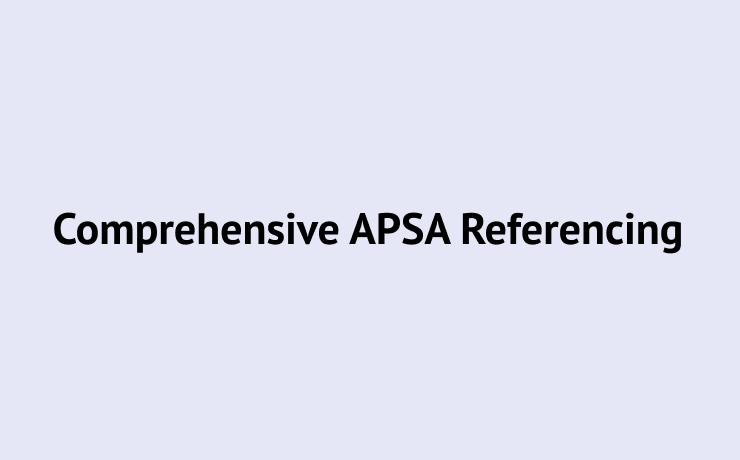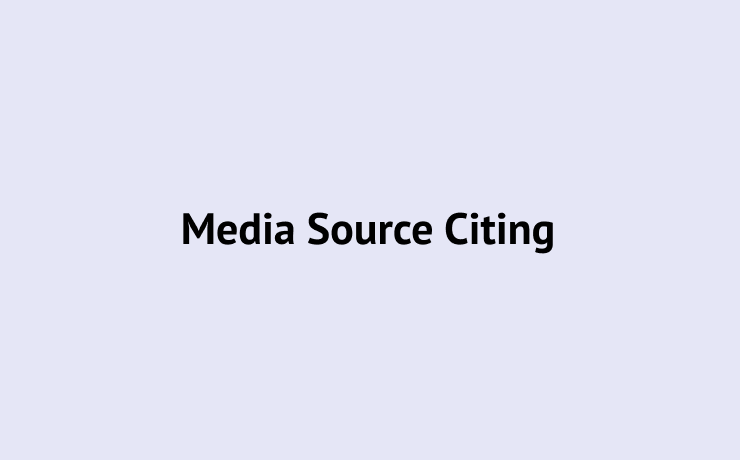Free APSA Citation Generator by Academichelp
Meet the Essential Features of the AcademicHelp's APSA Citation Machine

Proper Citations and References
Easily and quickly organize your in-text citations as well as a reference page for your work with our simple Free APSA Citation Generator. Create parenthetical citations, and cite multivolume works, periodicals, and online sources without the fear of making a mistake.
Reference Page Formatting
Our Free APSA Citation Generator will not leave behind any comma, ed dashes, and abbreviations when referencing needed works. You can rest assured that your sources are organized according to all the APSA style guidelines.
Accurate Audiovisual Content Referencing
Use all the necessary videos and podcasts for your academic paper. AcademicHelp’s APSA Citation Generator will handle their proper referencing for you.Automated and efficient APSA style generator

What is American Political Science Association Format
APSA (or American Political Science Association) is a formatting style used to properly prepare and reference manuscripts to be published in APSA journals. In most cases, it follows the guidelines of the Chicago Manual of Style, 17th edition (CMS). The main difference between these two citation rules is that in APSA you need to spell out both cardinal and ordinal numbers zero through nine in the text.
The APSA format sets specific rules for the type of content included in manuscripts, software to use for writing, and layout of the future publication. It is mostly used by scientific professionals writing in the fields of physical, natural, and social sciences.
General Rules for APSA Citation Machine References
The general American Political Science Association Style Guide was created to ensure consistency and clarity in academic writing, allowing easy navigation through text. Therefore, the reference list must include all the sources used by the author to create the paper. Each reference should be linked to at least one parenthetical citation within the manuscript.
For references, APSA uses an author-date style, where the year of publication is the second element in a reference, following the author’s name. This differentiates it from the notes and bibliography style of the Chicago Style 17th edition.
The general structure of the source reference should go as follows:
- Each part of a reference is separated by a period, with each part starting with a capital letter unless it is a lowercase part of a name.
- Names should be given as they appear in the source. The first author’s name is inverted (last name, first name), but subsequent authors’ names are not. Use ‘and’, not an ampersand (‘&’). For sources with ten or more authors, list the first seven followed by ‘et al.’ (do not use this abbreviation in any other case)
- If an organization, association, or corporation is the author, list it as such. Abbreviations are allowed but must be followed by the full name in the first reference.
- If no author is listed for the source, but editors or translators are, they are mentioned in the author’s place, with ‘ed.’, ‘eds.’, or ‘trans.’ following their names, preceded by a comma.
- In case there is no author, editor, translator, or sponsoring organization, the source title is used as the author.
- If the source was found, read, or used online, you should have a direct link to it, alongside all the citation data listed above. The order for citing such online sources is the following: DOI (digital object identifier), a permalink URL (uniform resource locator), and a short version of the URL.
Citing books, multivolume works, periodicals, and online content such as social media, websites, or blogs, requires the following of a separate set of rules. To find that information refer to the recent version of the APSA guidelines.
How to Use AcademicHelp APSA Citation Generator
AcademicHelp’s APSA Citation Generators offer two modes: manual and automatic. The first one will most suit you if you have all the information about a book or publication and just need to organize it properly. The second one is for the cases when you have some details, like DOI, link, or title of publication, but find difficulties retrieving all other information.
When you choose a mode that works best for you, all you need to do is enter key information that you have in a specified field and press the button to generate your APSA citations. You will have a properly formatted source just in a few seconds with even a few variations to best suit your style requirements.
How to Create APSA in Text Citation
In-text citations, or parenthetical citations, are brief notes that appear in the text as citations to provide immediate access to the information source used in the paper. These citations are needed to identify references for quotes, paraphrased sentences, summaries, and facts or opinions that are not generally known or easily checked.
Despite following the Chicago Style guidelines, the APSA paper format doesn’t separate two styles on in-text citations (notes and bibliography) but just uses the author-date formatting. Within this style, references are made in parentheses() within the text, not in footnotes or endnotes.
Following the general rules, parenthetical citations should look the following way:
- Include the last name of the author(s), editor(s), or translator(s) and the year of publication.
- If you can’t find the year of publication, use the ‘n.d.’ label. If the work is yet to be published, state ‘forthcoming’ in the publication year.
- The terms usually abbreviated in the reference list (ed. or eds. and trans) are skipped in the in-text citations.
- No commas should be placed between the last name and publication year.
- In cases of direct quotes, specific data, or to avoid ambiguity, include page or chapter numbers after the year, separated by a comma.
Parenthetical citations are generally placed at the end of a sentence before the period and aren’t separated by commas. With block quotes or when the author’s name is mentioned in the text, the citation follows the block quote’s punctuation or comes right after the author’s name mentioned in the text.
For more detailed instructions on citations with multiple authors or several works by one author, as well as other special cases in APSA, refer to the most recent version of the APSA manual.
